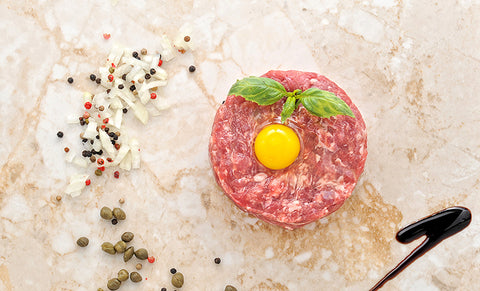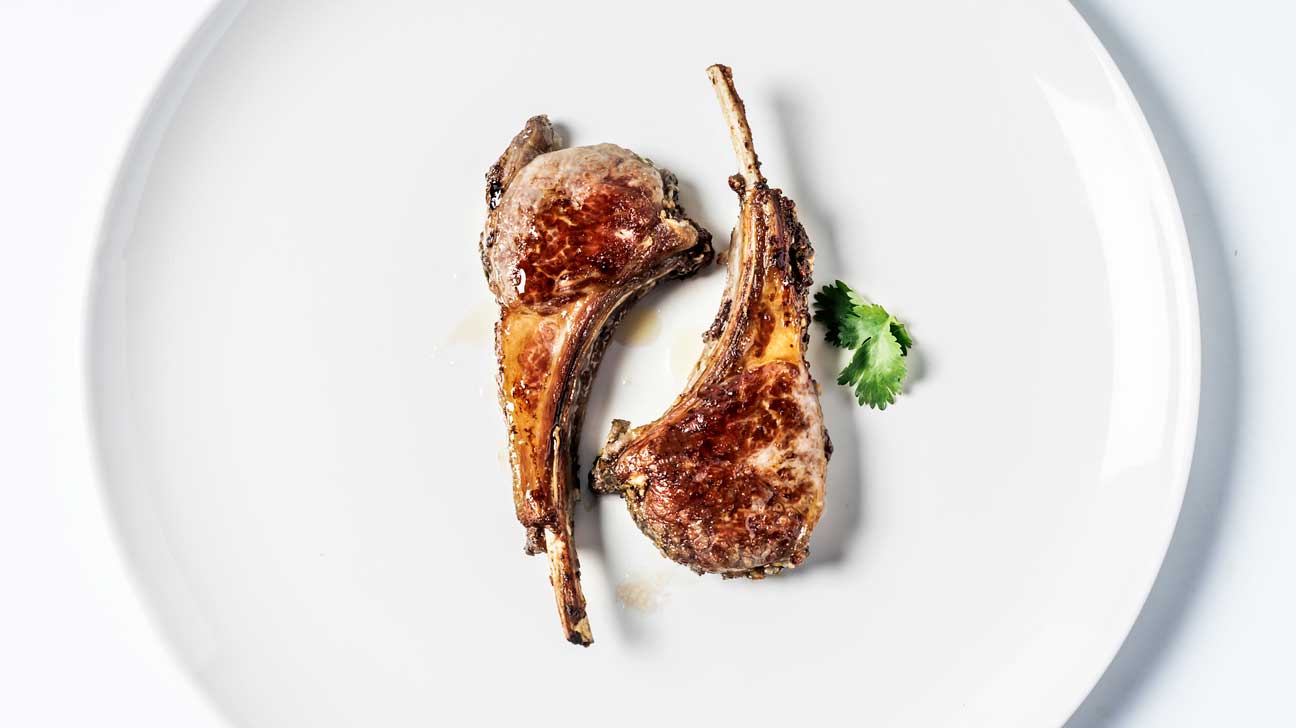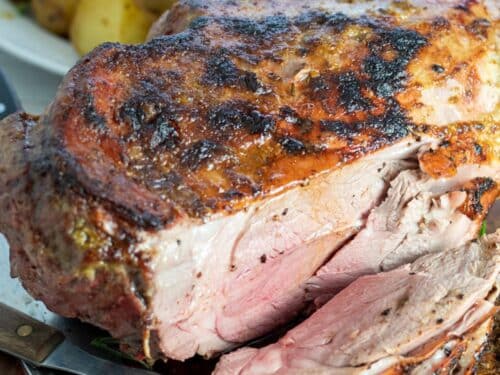
Introduction
The Popularity Of Lamb And Its Different Doneness Levels
Lamb is a popular meat choice for many people, thanks to its unique flavor and tender texture. When it comes to cooking lamb, there are different levels of doneness that can be achieved, ranging from rare to well done. The level of doneness you prefer may vary depending on your personal taste preferences, cultural background, or health considerations.
The Importance Of Knowing How To Cook Lamb Safely
While the doneness level of lamb is a matter of personal preference, it is important to prioritize food safety when preparing and cooking lamb. Proper handling, storage, and cooking temperatures are essential to ensure that the meat is not only flavorful but also safe to eat. Knowing which cuts of lamb are suitable for rare cooking and which should be avoided can help mitigate potential health risks.
It is recommended to follow the guidelines set by the USDA (United States Department of Agriculture) or similar food safety authorities in your country. These guidelines outline safe cooking temperatures for various cuts of lamb to minimize the risk of foodborne illnesses like salmonella or E. coli.
Some cuts of lamb are more suitable for rare cooking, while others require more thorough cooking to ensure safety. Here is a breakdown of common lamb cuts and their recommended cooking temperatures:
| Lamb Cut | Target Temperature for Rare |
|---|---|
| Rack of lamb | 125°F to 130°F (51°C to 54°C) |
| Loin chops | 145°F (63°C) |
| Leg of lamb | 145°F (63°C) |
| Shoulder chops | 160°F (71°C) |
It is crucial to use a food thermometer to ensure that the lamb has reached the recommended internal temperature. This will guarantee that any harmful bacteria present on the meat have been effectively killed, reducing the risk of foodborne illnesses.
To summarize, understanding the different cuts of lamb, their recommended cooking temperatures, and prioritizing food safety are essential when deciding how to prepare and cook lamb. By following the proper guidelines, you can enjoy the delicious taste of lamb while ensuring it is safe to eat.
Is It Safe To Eat Lamb Rare?
Exploring The Safety Of Eating Lamb Rare
Lamb is a popular meat choice for its unique flavor and tender texture. When it comes to cooking lamb, there are different levels of doneness that can be achieved, ranging from rare to well done. The level of doneness you prefer may vary depending on your personal taste preferences, cultural background, or health considerations.
It is important to prioritize food safety when preparing and cooking lamb. Proper handling, storage, and cooking temperatures are essential to ensure that the meat is not only flavorful but also safe to eat. Knowing which cuts of lamb are suitable for rare cooking and which should be avoided can help mitigate potential health risks.
Understanding The Risks And Precautions
To ensure safe consumption of lamb, it is recommended to follow the guidelines set by food safety authorities. For example, the USDA (United States Department of Agriculture) provides guidelines for safe cooking temperatures for various cuts of lamb to minimize the risk of foodborne illnesses like salmonella or E. coli.
Some cuts of lamb are more suitable for rare cooking, while others require more thorough cooking to ensure safety. Here is a breakdown of common lamb cuts and their recommended cooking temperatures:
- Rack of lamb: 125°F to 130°F (51°C to 54°C)
- Loin chops: 145°F (63°C)
- Leg of lamb: 145°F (63°C)
- Shoulder chops: 160°F (71°C)
Using a food thermometer is crucial to ensure that the lamb has reached the recommended internal temperature. This will guarantee that any harmful bacteria present on the meat have been effectively killed, reducing the risk of foodborne illnesses.
In conclusion, understanding the different cuts of lamb, their recommended cooking temperatures, and prioritizing food safety are essential when deciding how to prepare and cook lamb. By following the proper guidelines, you can enjoy the delicious taste of lamb while ensuring it is safe to eat.
What Is The Target Temperature For Rare Lamb?
The Recommended Internal Temperature For Rare Lamb
When it comes to cooking lamb, achieving the right level of doneness is key. For those who prefer their lamb rare, it is important to cook it to the proper internal temperature to ensure both taste and safety. The recommended target temperature for rare lamb varies depending on the cut, but it generally falls between 125°F to 130°F (51°C to 54°C) for cuts like rack of lamb and 145°F (63°C) for cuts like loin chops and leg of lamb.
Why It Is Crucial To Reach The Right Temperature
Reaching the right temperature when cooking lamb is crucial to ensure that any potentially harmful bacteria present on the meat are effectively killed off. Consuming undercooked lamb can increase the risk of foodborne illnesses like salmonella or E. coli. By using a food thermometer to check the internal temperature, you can ensure that the lamb has reached the recommended target temperature for rare cooking, guaranteeing both flavor and safety.
Proper handling, storage, and cooking temperatures are essential to ensure that your lamb is not only tasty but also safe to eat. By understanding the recommended cooking temperatures for different cuts of lamb and using a food thermometer, you can confidently prepare your lamb rare without compromising on food safety.

What Is The Target Temperature For Rare Lamb?
The Recommended Internal Temperature For Rare Lamb
When cooking lamb, it is important to reach the right level of doneness to ensure both taste and safety. For those who prefer their lamb rare, the recommended target temperature can vary depending on the cut. Generally, cuts like rack of lamb should be cooked to an internal temperature of 125°F to 130°F (51°C to 54°C) for rare doneness. For cuts like loin chops and leg of lamb, the recommended temperature for rare cooking is 145°F (63°C).
Why It Is Crucial To Reach The Right Temperature
Reaching the proper temperature when cooking lamb is crucial to ensure any potential bacteria on the meat are killed off. Consuming undercooked lamb can pose a risk of foodborne illnesses such as salmonella or E. coli. By using a food thermometer, you can check the internal temperature of the lamb and ensure it has reached the recommended target temperature for rare cooking. This guarantees both flavor and safety.
Proper handling, storage, and cooking temperatures are essential to ensure your lamb is not only delicious but also safe to eat. By understanding the recommended cooking temperatures for different cuts of lamb and utilizing a food thermometer, you can confidently prepare your lamb rare without compromising on food safety.
Lamb Cooking Temperatures And Doneness Chart
A Comprehensive Chart Of Lamb Cooking Temperatures And Doneness Levels
Here is a handy chart that provides guidelines for achieving different levels of doneness when cooking lamb:
| Doneness Level | Optimal Internal Temperature |
|---|---|
| Rare | 120°F (50°C) |
| Medium Rare | 130°F (54°C) |
| Medium | 140°F (60°C) |
| Medium Well | 145°F (65°C) |
| Well Done | 160°F (70°C) |
By referring to this chart, you can easily determine the optimal internal temperature for your desired level of doneness when cooking lamb. Keep in mind that these temperatures are just guidelines, and personal preference may vary.
In summary, achieving the right temperature when cooking lamb is crucial for both taste and safety. By using a food thermometer and understanding the recommended cooking temperatures for different cuts, you can ensure that your lamb is both delicious and safe to eat.
Searing For Safety: Proper Preparation Techniques
The Significance Of Searing In Ensuring Safety
Proper preparation techniques, such as searing, play a crucial role in ensuring the safety of lamb. Searing lamb before cooking helps kill potential bacteria on the meat’s surface, reducing the risk of foodborne illnesses. Searing involves cooking the lamb over high heat for a short period, which not only enhances the flavor but also creates a delicious crust that adds texture to the meat.
How Searing Kills Bacteria And Enhances Flavor
When the surface of the lamb is exposed to high heat during searing, any bacteria present are rapidly killed off. This is because the high temperature creates an environment where bacteria cannot survive. Additionally, searing helps enhance the flavor of the lamb by creating a caramelized crust that adds depth and richness to the meat.
To properly sear lamb, follow these steps:
- Preheat a skillet or grill pan over high heat.
- Season the lamb with salt and pepper.
- Add a small amount of oil to the hot pan.
- Place the lamb in the pan and cook for a few minutes on each side until a golden brown crust forms.
- Transfer the seared lamb to a preheated oven to continue cooking to the desired level of doneness.
By searing the lamb before further cooking, you not only ensure its safety by killing off any surface bacteria but also enhance its flavor and texture. Remember to always use a food thermometer to check the internal temperature of the lamb and ensure it reaches the recommended target temperature for rare cooking or your desired level of doneness.
In summary, searing plays a significant role in ensuring the safety and taste of lamb. By following proper preparation techniques, such as searing, you can enjoy a delicious and safe meal.
Best Cuts Of Lamb For Rare Doneness
Identifying The Cuts Of Lamb That Are Suitable To Be Eaten Rare
When it comes to enjoying lamb cooked rare, there are a few cuts that are particularly well-suited for this level of doneness. These cuts tend to be more tender and have less connective tissue, making them ideal for a rare cooking method. Here are some of the best cuts of lamb to consider:
- Rack of lamb: The rack of lamb is a popular choice for a rare doneness. It is a tender and flavorful cut that is often cooked whole and then sliced into individual chops.
- Lamb chops: Lamb chops, whether rib chops or loin chops, are also great for rare cooking. These cuts cook quickly and are best when they still have a pink, juicy center.
- Lamb tenderloin: The lamb tenderloin, also known as the fillet, is a lean cut that is tender and well-suited for rare cooking. It is often used in gourmet dishes and can be roasted or grilled.
- Lamb loin: The lamb loin, similar to beef tenderloin, is a lean and tender cut that is suitable for rare doneness. It can be cooked whole or cut into individual steaks.
Tips For Selecting The Right Cuts
When choosing lamb cuts for rare cooking, there are a few things to keep in mind to ensure the best results:
- Look for cuts that are tender and have less connective tissue. These cuts will be more suited for rare cooking.
- Consider the thickness of the cut. Thicker cuts may require longer cooking time to reach a rare doneness.
- Ask your butcher for recommendations. They can provide guidance on the best cuts for rare cooking and may even have specific cuts available for this purpose.
By selecting the right cuts of lamb and properly preparing them, you can enjoy a delicious and safely cooked rare lamb dish. Remember to always use a food thermometer to ensure that the lamb reaches the recommended target temperature for rare cooking or your desired level of doneness.
Proper Food Safety Practices For Rare Lamb
Key Food Safety Practices To Follow When Cooking Lamb Rare
When cooking lamb rare, it is important to follow proper food safety practices to ensure that your meal is not only delicious, but also safe to eat. Here are some key practices to keep in mind:
- Thoroughly wash your hands before and after handling raw lamb. This helps to prevent the spread of bacteria.
- Keep raw lamb separate from other foods, especially those that will not be cooked. This helps to prevent cross-contamination.
- Use separate cutting boards and utensils for raw lamb and other foods to avoid the transfer of bacteria.
- Ensure that the lamb is properly stored in the refrigerator before cooking. Keep it in a sealed container or wrap it tightly to prevent exposure to other foods.
- When marinating lamb, always do so in the refrigerator. Do not leave it at room temperature, as this can promote bacterial growth.
- Cook lamb to the recommended internal temperature to ensure that any potential bacteria is killed. For rare lamb, the target temperature is 125°F (52°C).
- If you are using a meat thermometer to check the doneness of the lamb, insert it into the thickest part of the meat without touching bone or fat.
- Allow the lamb to rest for a few minutes after cooking. This helps to distribute the juices and ensures that it is cooked evenly.
Preventing Cross-contamination And Ensuring Safe Consumption
In addition to following the key food safety practices mentioned above, there are a few more precautions you can take to ensure the safe consumption of rare lamb:
- Choose reputable sources for your lamb. This helps to minimize the risk of contamination.
- Check the lamb for any signs of spoilage, such as a foul odor or slimy texture. If you notice any of these signs, do not consume the lamb.
- Properly clean and sanitize your cooking surfaces, utensils, and equipment after handling raw lamb to prevent the spread of bacteria.
- Ensure that your refrigerator is set to the proper temperature (below 40°F or 4°C) to slow down the growth of bacteria.
- Consume the cooked rare lamb within 3-4 days to minimize the risk of bacterial growth.
By following these food safety practices and taking necessary precautions, you can safely enjoy rare lamb without compromising on taste or quality.

Safest Temperature And Doneness To Eat Lamb
Exploring The Safest Temperature And Doneness Level To Consume Lamb
Lamb is a popular choice of meat known for its rich flavor and tenderness. But when it comes to consuming lamb, it’s important to consider the safest temperature and doneness level to ensure both taste and food safety. Here are some key points to keep in mind:
- The target temperature for rare lamb is 125°F (52°C). This ensures that any potential bacteria in the meat is killed during the cooking process. It’s important to use a meat thermometer to accurately measure the internal temperature of the lamb.
- Cook lamb to medium-rare or medium if you prefer a slightly higher doneness level. Medium-rare lamb has an internal temperature of about 135°F (57°C), while medium lamb has an internal temperature of about 145°F (63°C). These temperatures offer a balance between taste and safety.
- Avoid eating lamb that is cooked to rare or below rare temperatures, as this increases the risk of foodborne illnesses. The internal temperature of rare lamb is below the recommended temperature for killing bacteria.
Balancing Taste Preferences With Food Safety Guidelines
While rare lamb may be tempting for its succulent and tender texture, it’s crucial to prioritize food safety. Here are some guidelines to help you strike a balance between your taste preferences and the necessary precautions:
- Choose reputable sources for your lamb to minimize the risk of contamination. Look for trusted suppliers or local farms that prioritize food safety practices.
- Inspect the lamb for any signs of spoilage, such as a foul odor or slimy texture. If you notice any of these signs, it’s best to discard the lamb and not consume it.
- Properly clean and sanitize all cooking surfaces, utensils, and equipment after handling raw lamb to prevent the spread of bacteria.
- Set your refrigerator temperature below 40°F (4°C) to slow down the growth of bacteria. This ensures that the lamb stays fresh and safe for consumption.
- Consume cooked lamb within 3-4 days to minimize the risk of bacterial growth. If you have leftovers, store them in airtight containers in the refrigerator.
By following these guidelines, you can enjoy lamb cooked to your desired level of doneness while still prioritizing food safety. Remember to always handle raw lamb with care and cook it to the recommended internal temperatures to ensure a safe and delicious meal.
Safest Temperature And Doneness To Eat Lamb
Exploring The Safest Temperature And Doneness Level To Consume Lamb
Lamb is a popular choice of meat known for its rich flavor and tenderness. When it comes to consuming lamb, it’s important to consider the safest temperature and doneness level to ensure both taste and food safety. Here are some key points to keep in mind:
- The target temperature for rare lamb is 125°F (52°C). This ensures that any potential bacteria in the meat is killed during the cooking process. It’s important to use a meat thermometer to accurately measure the internal temperature of the lamb.
- Cook lamb to medium-rare or medium if you prefer a slightly higher doneness level. Medium-rare lamb has an internal temperature of about 135°F (57°C), while medium lamb has an internal temperature of about 145°F (63°C). These temperatures offer a balance between taste and safety.
- Avoid eating lamb that is cooked to rare or below rare temperatures, as this increases the risk of foodborne illnesses. The internal temperature of rare lamb is below the recommended temperature for killing bacteria.
Balancing Taste Preferences With Food Safety Guidelines
While rare lamb may be tempting for its succulent and tender texture, it’s crucial to prioritize food safety. Here are some guidelines to help you strike a balance between your taste preferences and the necessary precautions:
- Choose reputable sources for your lamb to minimize the risk of contamination. Look for trusted suppliers or local farms that prioritize food safety practices.
- Inspect the lamb for any signs of spoilage, such as a foul odor or slimy texture. If you notice any of these signs, it’s best to discard the lamb and not consume it.
- Properly clean and sanitize all cooking surfaces, utensils, and equipment after handling raw lamb to prevent the spread of bacteria.
- Set your refrigerator temperature below 40°F (4°C) to slow down the growth of bacteria. This ensures that the lamb stays fresh and safe for consumption.
- Consume cooked lamb within 3-4 days to minimize the risk of bacterial growth. If you have leftovers, store them in airtight containers in the refrigerator.
By following these guidelines, you can enjoy lamb cooked to your desired level of doneness while still prioritizing food safety. Remember to always handle raw lamb with care and cook it to the recommended internal temperatures to ensure a safe and delicious meal.
Conclusion
Summarizing The Key Takeaways From The Article
In conclusion, understanding the safest temperature and doneness level to consume lamb is essential for both taste and food safety. Cooking lamb to a target temperature of 125°F ensures that any potential bacteria is killed during the cooking process. Medium-rare or medium lamb offers a balance between taste and safety with internal temperatures of about 135°F and 145°F respectively. It’s important to avoid consuming lamb cooked to rare or below rare temperatures to reduce the risk of foodborne illnesses.
Additionally, prioritizing food safety guidelines such as choosing reputable sources, inspecting the lamb for signs of spoilage, and properly cleaning and sanitizing cooking surfaces are crucial. Setting the refrigerator temperature below 40°F and consuming cooked lamb within 3-4 days also contribute to minimizing bacterial growth.
Encouraging Readers To Enjoy Lamb Safely And Deliciously
By following these recommendations and making informed choices, you can safely enjoy lamb at your desired level of doneness. Prioritizing food safety practices and handling lamb with care ensures not only a delicious meal but also peace of mind. So go ahead and savor the flavors of lamb while keeping health and safety in mind.
FAQ: Can You Eat Lamb Rare? Exploring Lamb Doneness Levels
Q: Can lamb be eaten rare?
A: Yes, lamb can be eaten rare. The level of doneness is a matter of personal preference. Lamb is highly versatile and can be enjoyed with varying degrees of cooking.
Q: What are the different doneness levels for lamb?
A: There are four main doneness levels for lamb: rare, medium-rare, medium, and well done.
Q: How is lamb cooked to rare doneness?
A: For rare doneness, lamb is seared on high heat for a short period, leaving the center pink and juicy. The internal temperature typically ranges between 125-130°F (52-54°C).
Q: Is rare lamb safe to eat?
A: Consuming rare lamb is generally safe if sourced from reputable suppliers and handled properly. However, it is essential to ensure that the lamb has been cooked to a safe internal temperature to eliminate any potential health risks.
Q: What is the texture of rare lamb like?
A: Rare lamb has a very tender and succulent texture, with a juicy and flavorsome center. The meat will be pink, resulting in a more robust taste compared to higher doneness levels.
Q: Can lamb be eaten medium-rare?
A: Absolutely! Medium-rare is another popular doneness level for lamb. It involves slightly more cooking time than rare. The internal temperature typically ranges between 130-140°F (54-60°C), resulting in a slightly pink center.
Q: What is the advantage of cooking lamb medium-rare?
A: Cooking lamb to medium-rare allows the flavors to develop further while retaining juiciness and tenderness. It strikes a balance between the natural richness of lamb and a bit more caramelization on the exterior.
Q: Can lamb be cooked to medium doneness?
A: Yes, cooking lamb to medium doneness is also an option. The internal temperature typically ranges between 145-160°F (63-71°C), resulting in a slightly pink to light brown interior.
Q: What does medium doneness offer in terms of taste and texture?
A: Cooking lamb to medium doneness creates a firmer texture while still maintaining juiciness. It provides a well-balanced flavor profile, as some of the natural juices are retained in the meat.
Q: Can lamb be well done?
A: Yes, lamb can be cooked to well done. The internal temperature ranges between 160-170°F (71-77°C), resulting in a fully cooked, browned, and firm texture throughout. However, it is important to note that lamb can become slightly drier when cooked to this level.
Q: Are there any recommended cooking methods for lamb?
A: Lamb can be cooked using various methods, including grilling, roasting, pan-searing, or slow cooking. Each method offers unique flavors and textures, so feel free to experiment and find your preferred way of cooking lamb.
Q: Can I trust the color of the meat to determine its doneness?
A: While color can provide some clues about the doneness level, it is always recommended to use a meat thermometer to ensure accuracy. Relying solely on color may lead to misjudging the doneness and potentially under or overcooking the meat.
In conclusion, lamb can be enjoyed at different doneness levels depending on personal preference. Whether you prefer rare, medium-rare, medium, or well done, ensure that the lamb has been cooked to a safe internal temperature to guarantee both flavor and safety.

Keep up with weekly specials through Facebook under “The Grill at Great Bridge.”